“Orthodoxy from the Third Coast”? What’s that? See “About”, upper right.
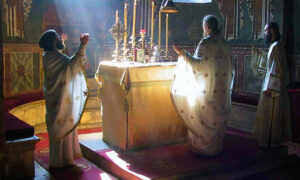
Since 2019 I have been writing a l o n g series on the Divine Liturgy.
If you want to go back and review:
1 Posts 151 and 152 – The Proskimidi: the Service of Preparation
2 Post 163 – How we should prepare ourselves for Divine Liturgy
3 Post 164 – The basics about the Divine Liturgy
4 Posts 165 and 166 – The Pro-Anaphora
Just search for “Father Bill’s Orthodox Blog Post 151” – or whichever.
I held off the Anaphora in order to conclude during Great Lent with our Lenten Sunday Liturgy’s wonderful Anaphora of Saint Basil – and began last year, only to be interrupted by the Great Pandemic. So let’s try again. After all this time, I think we need a quick re-introduction, so forgive me if I repeat a few things before we move ahead.
Introduction
The text of Saint Basil’s Liturgy is found in some “private” prayer books, or perhaps you can find a copy at church. On line go to: https://www.goarch.org/-/the-divine-liturgy-of-saint-basil-the-great
Did you know that for many centuries Saint Basil’s Liturgy was celebrated every Sunday, and Saint John Chrysostom was only for weekdays. Now poor Basil is reduced to ten times a year – Lenten Sundays plus a few other days. The only difference between the two Liturgies is found in the Anaphora.
As you’ll remember, “Anaphora” (αναφόρηση) means “offering”. In the Anaphora we participate, through these Holy Gifts of Bread and Wine, in Christ’s Sacrifice, His Offering of Himself to the Father, His Incarnation, and “the cross, the grave, the third-day resurrection, the ascension into heaven, the sitting at the right hand, and the second and glorious coming.”
The first part of the Divine Liturgy is usually called the Pro-Anaphora. The Anaphora is the latter part of the Divine Liturgy which begins with the Great Entrance. Though with typical Orthodox inconsistency, we also say that the Anaphora begins later with the prayer of consecrating and offering of the Holy Gifts.
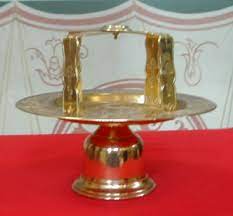 You’ll recall that during the Proskomidi before Divine Liturgy, the Priest “constructed” on the Diskos an image of the Church:
You’ll recall that during the Proskomidi before Divine Liturgy, the Priest “constructed” on the Diskos an image of the Church:
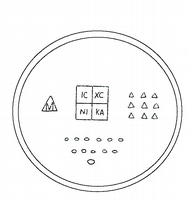 Christ in the center, the Holy Theotokos to the left (that is, to Christ’s right!), and the categories of Saints on the right. At the bottom he placed particles of the Bread, each representing 1) the Bishop and other persons important to himself, 2) persons living and departed requested by those who provided the Prosphora, 3) others for whom prayers have been asked.
Christ in the center, the Holy Theotokos to the left (that is, to Christ’s right!), and the categories of Saints on the right. At the bottom he placed particles of the Bread, each representing 1) the Bishop and other persons important to himself, 2) persons living and departed requested by those who provided the Prosphora, 3) others for whom prayers have been asked.
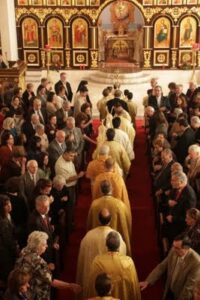 The Great Entrance
The Great Entrance
Now, accompanied by Cross, fans, candles and incense the Priest carries these Holy Gifts (carries the whole Church) out the north door of the Altar, down the north aisle, back up the main aisle through the congregation and finally through the Royal Doors into the Altar. In symbol he is “picking up” each of us and our needs and cares, and carrying us to the Altar.
above: courtesy of Saint George Greek Orthodox Cathedral, Greenville, South Carolina
During the Great Entrance the Cherubic Hymn is sung:
Courtesy of “Orthodox Christian Chants” website
Before he enters the Altar, he offers in prayer the names of those who have given the Prosphora and those for whom they have asked prayers, as well as others.
Then the Priest passes through the Royal Doors. In symbol, the Little Entrance carried us to the “lower Heaven”. (I don’t know how else to say this. In 2 Corinthians 12:2-4 Paul describes how he was taken up into the “third heaven” of the traditional seven.) This Great Entrance leads us to the “Highest Heaven”, to the Altar of God and the Eternal Sacrifice of Jesus Christ. In symbol, the Priest places us on that Altar table, as we offer ourselves to the Father through Jesus Christ our Lord, by the power of the Holy Spirit.
A Litany then follows, which unfortunately interrupts the flow. My guess is that during the early years, Litanies were inserted into Orthodox services in order to give the Priest and cantor a chance to catch their breath before whatever comes next! I could be wrong.
The Exchange of Peace and the Creed
The reciting of the Creed was (by Orthodox standards) one of the last additions to the Liturgy – late Fifth Century. It plays a different function for us than it does in the West. You can tell this by where it’s placed. In the West the Creed comes earlier, immediately after the Scripture readings, where it seems chiefly an intellectual affirmation of the Church’s teaching. In the Orthodox Liturgy, the Creed is more an affirmation of our faith, our trust in God. After all, the Creed has always begun “I believe in one God…”, not “I believe that there is one God…” It is preceded by the words “Let us love one another, that with one accord we may confess: Father, Son and Holy Spirit, the Trinity, one in essence and undivided” and the Exchange of Peace. Without love for each other, we cannot grasp the Faith. Love is primary, not intellect.
Let’s talk about the Exchange of Peace. In the early Church, all exchanged the Peace at this point. Then for many centuries it was limited to the clergy – I don’t know why. Now the 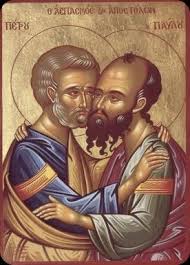 people sometimes participate again. Some years ago our Antiochian Metropolitan Philip (+ memory eternal) directed this to be done, and at our Saint Nicholas, Cedarburg, it now seems a very natural thing to do. It is also significant theologically, for Christ is present not only in His Body the Holy Eucharist, but also in His Body the Church, in the people around us. That is why at the Peace Orthodox say “Christ is in our midst.” “He is and shall be.”
people sometimes participate again. Some years ago our Antiochian Metropolitan Philip (+ memory eternal) directed this to be done, and at our Saint Nicholas, Cedarburg, it now seems a very natural thing to do. It is also significant theologically, for Christ is present not only in His Body the Holy Eucharist, but also in His Body the Church, in the people around us. That is why at the Peace Orthodox say “Christ is in our midst.” “He is and shall be.”
Icons courtesy of Saint Isaac’s Skete at skete.com
If the Peace is to be exchanged, people need to understand that this is a liturgical gesture, not an introduction to coffee hour. Before I was Orthodox, I visited a Eucharistic service in a different church. At the Peace I said, properly, to the man next to me “Peace be with you”. He responded “Yeah, how ya doin’, buddy?” Please, none of this in the Orthodox Church!
Next, the Deacon sings the oddest thing: “The Doors! The Doors! In wisdom, let us attend.” Why ever? Anciently, remember, only baptized Christians attended the Anaphora, since how could non-Christians recite the Creed in sincerity? or offer or receive the Holy Gifts when they didn’t believe in them? So the doorkeepers (ushers in today’s terms) were now told to guard “the doors! the doors!” lest anybody else should get in. (Why does he still sing it today? Because we Orthodox never throw out anything, that’s why.) And then the usual directions to the people when something important is about to happen: “Let us attend!” Pay attention!
The Creed follows immediately. Some other time we’ll have a series about that.
Now at last comes the central prayer of the Anaphora. Of necessity I’ll omit much of the text here.
The Anaphora Prayer
The Deacon begins: “Let us stand aright. Let us stand with fear. Let us attend, that we may offer the Holy Oblation in peace.”
A dialog between Priest and People follows: The Priest: “Let us lift up our hearts.” The people: “We lift them up to the Lord.” Father Alexander Schmemann said these are the most important words of the Liturgy. The Divine Liturgy began with the words: “Blessed is the Kingdom of the Father of the Son and of the Holy Spirit”. From then till now, the whole goal of the Liturgy is this: that we be lifted up into God’s Heavenly Kingdom, our true Home. And now, here we are.
As I said, thus far Saint Basil’s Liturgy has been almost the same as our usual Saint John Chrysostom. Now things change. However, in many Orthodox churches you’d never know it, because Basil’s beautiful Anaphora is said silently. (Some Priests say, um…, that they “scan” it.) This has gone on for many centuries – and so this treasure of the Church has sadly been hidden from the people. (Although if the Liturgy is not in a language people can understand, it really doesn’t make much difference, does it?)
 from Ortho-Christian.com
from Ortho-Christian.com
But these are the Peoples’ Prayers. The whole Church is priestly. “… You are a chosen race, a royal priesthood, a holy nation, I Peter 2:9 “To Him who loves us and has freed us from our sins by His blood, and has made us to be a kingdom and priests to serve His God and Father—to Him be glory and power for ever and ever! Amen.” Revelation 1:5-6 The function of the Priest * standing up front in those lovely vestments is not to be the only priest, but to lead the People of God in our priestly prayers.
- If I understand correctly, in the original text he is called not ιερός (priest) but πρεσβύτερος (presbyter, which means “elder”). The English word “priest” is an abbreviation of “presbyter”.
Priests are mediators between this world and the other. Jesus Christ is the One True Priest, and He shares His priesthood with all who are members of His Body, the Church. We who are baptized live in two worlds – not only on this earth but are also citizens of the Kingdom of Heaven. Our work is to offer up ourselves and the world around us to the Father, and to bring the Kingdom of God, the love of God into this world. The Divine Liturgy is the focus of our priestly work.
For this reason, anciently the Anaphora was always said aloud. But we clergy got lazy or maybe just wanted to save time, so that already in the Fifth Century the Emperor Justinian had to direct that these prayers must again be said aloud. The clergy ignored him, and that was that for 1500 years.
In many places the Anaphora is being restored to the people. At Saint Nicholas, we’ve found Saint Basil’s Anaphora, said aloud in its entirety, takes about five minutes or a little longer – not that we’re counting, of course… Thus far nobody has died of it. Many people have come to appreciate it for its beauty, its depth, its truth. (OK, some just endure it, but even that does them good – it’s Lent.)
“Five minutes longer” – and what a great five minutes! I knew an Episcopalian priest who heard Saint Basil’s Liturgy for the first time, was deeply moved by it, so overwhelmed he began to cry. (He has now been an Orthodox priest for many years.) Not only is Saint Basil’s language gorgeous, but it is the best summary I know of the Orthodox Faith and of our “salvation history”. We are all influenced by Western ways of thinking (both religious and secular), so I think we all need to hear again and again this great statement of Orthodox understanding of God’s mighty works – and just let it soak into us.
So if the Anaphora is said aloud in your church, please don’t tune it out. Listen to it. Pray it. And if in your parish it is still said silently, find yourself a copy of the text and read it to yourself during Liturgy, and take part in this Great Offering.
Introduction to The Thrice Holy Hymn
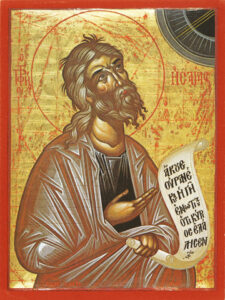 The prophet Isaiah in his vision of Heaven (Isaiah 6:1-4) heard the Seraphim singing “Holy, holy, holy, Lord God of hosts…” After our Little Entrance into the Altar, as we moved in spirit into the Kingdom of Heaven, we sang our first Thrice-Holy Hymn, usually called the Trisagion Hymn. Now after our Great Entrance into the Highest Heaven, we sing our second Thrice Holy Hymn.
The prophet Isaiah in his vision of Heaven (Isaiah 6:1-4) heard the Seraphim singing “Holy, holy, holy, Lord God of hosts…” After our Little Entrance into the Altar, as we moved in spirit into the Kingdom of Heaven, we sang our first Thrice-Holy Hymn, usually called the Trisagion Hymn. Now after our Great Entrance into the Highest Heaven, we sing our second Thrice Holy Hymn.
Both Saint John Chrysostom and Saint Basil appropriately preceded the Hymn with a “build up” of praise to the glory of God. Saint Basil’s is magnificent:
“Who is worthy to praise Your mighty acts? Or to make known all Your praises? Or tell of all Your wonderful deeds at all times? Master of all things, Lord of heaven and earth, and of every creature visible and invisible, You are seated upon the throne of glory and behold the depths. You are without beginning, invisible, incomprehensible, beyond words, unchangeable… Father… Son… Holy Spirit…” “…You are praised by the angels, archangels, thrones, dominions, principalities, authorities, powers, and the many eyed Cherubim. Round about You stand the six-winged Seraphim; with two they cover their faces; with two they cover their feet; with two they fly, crying out to one another with unceasing voices and ever-resounding praises…”
And then for the second time in the Divine Liturgy, we sing with them their Thrice-Holy Hymn: “Holy, holy, holy, Lord God of hosts, Heaven and earth are full of Your glory. Hosanna in the highest.”
But now we add something: “Blessed are You who come in the Name of the Lord. Hosanna in the highest!” For by the power of the Holy Spirit, Christ our God now comes to us in the Holy Eucharist – and we have now been lifted up to be with Him. We have passed beyond earthly time and space. We are now in the Kingdom on high.
+ + + + + + +
Next week Saint Basil’s Anaphora continues.
Father Bill,
Your blogs are wonderful. Two other
Cherubic hymns you might enjoy are by Tchaikovsky and Rachmaninoff. They hit it out of the park!
Hronia Pola! May you have many years.
Michael
I forgot to say you can find them on YouTube.
Thank you, Michael. I found the Tschaikovsky at https://www.youtube.com/watch?v=ggUtlUHIqQQ and the Rachmaninoff at https://www.youtube.com/watch?v=STBEultmudE
Dear Fr. Bill, I very much like and approve of your blog’s expanded title. We are always hearing about trends etc. that begin on either of the U.S.’s coasts, but very little about how people (especially Orthodox people) in the vastness between the two coasts think and act. It’s good to remember that the Upper Midwest-Great Lakes area is a “coast” too.
That comment came from my wife! (Don’t tell anybody.)